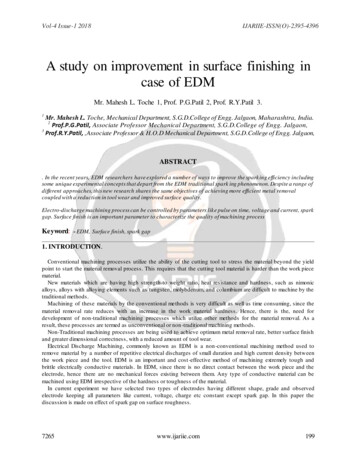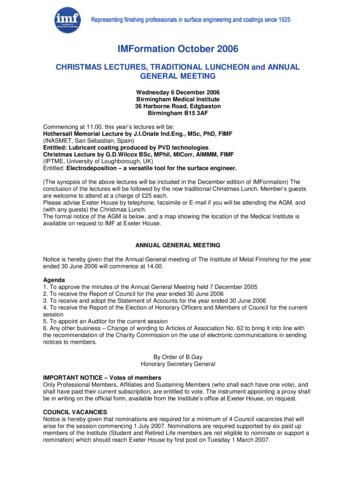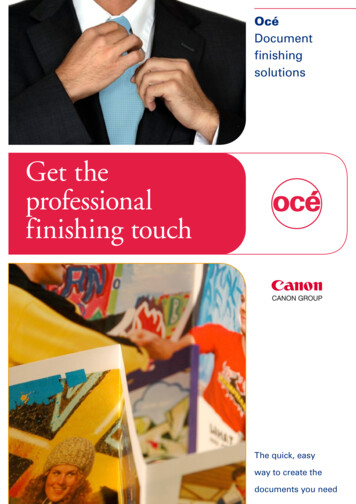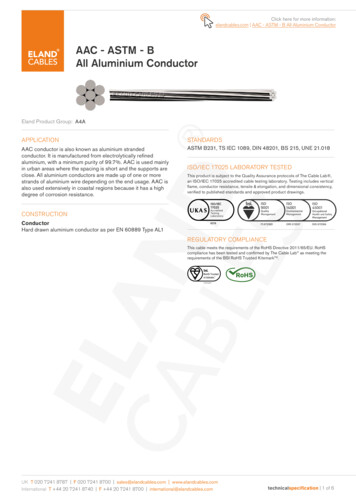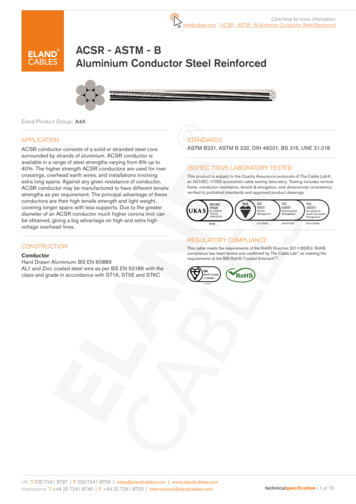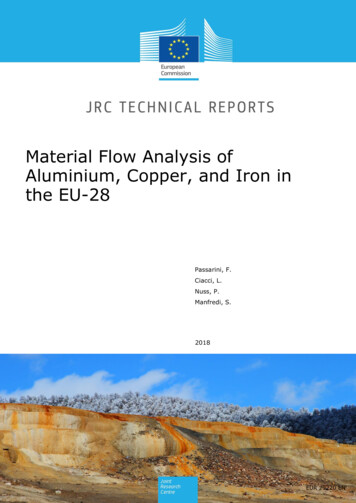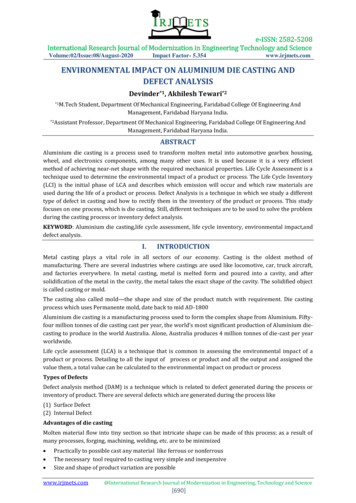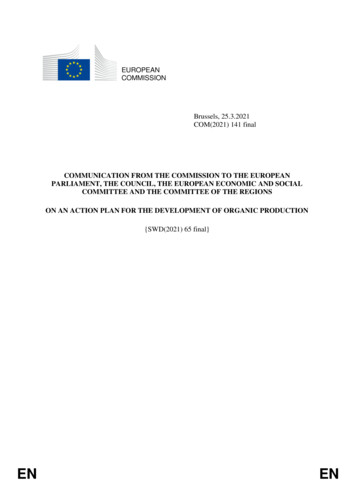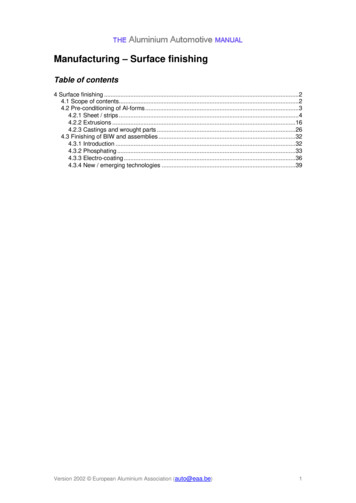
Transcription
Manufacturing – Surface finishingTable of contents4 Surface finishing .24.1 Scope of contents.24.2 Pre-conditioning of Al-forms .34.2.1 Sheet / strips .44.2.2 Extrusions .164.2.3 Castings and wrought parts .264.3 Finishing of BIW and assemblies .324.3.1 Introduction .324.3.2 Phosphating .334.3.3 Electro-coating .364.3.4 New / emerging technologies .39Version 2002 European Aluminium Association (auto@eaa.be)1
4 Surface finishing4.1 Scope of contentsIn this chapter, the surface finishing of aluminium for auto applications is considered in 2parts:1. Pre-conditioning of aluminium forms.This covers the range of surface conditioning treatments applied by the Al-industry to semifabricated forms sheets / strip / blanks, extrusions, castings and wrought partsbefore supply to the auto-manufacturer.2. Finishing of BIW & assemblies.This covers the surface conditioning treatments typically applied by the auto-manufacturerafter assembly of the BIW or sub-assemblies: Phosphating Electro-coatingIn addition, a few comments on emerging technologies are included.Version 2002 European Aluminium Association (auto@eaa.be)2
4.2 Pre-conditioning of Al-formsThis section describes the main surface conditioning processes applied by thealuminium supply industry: sheet products (coil or blanks) extruded products cast & wrought productsCoils productsSource: AlcanExamples of extruded productsSource: HydroExample of a cast engine blockVersion 2002 European Aluminium Association (auto@eaa.be)3
4.2.1 Sheet / stripsSurface conditioning of sheet & stripThis section describes the main surface conditioning technologies which are typically appliedto aluminium auto-sheet prior to supply to the auto manufacturer (as coil or blanks). Surface texturing (to produce increased roughness and a more isotropic surface) Cleaning of aluminium sheet & strip (to remove process oils, contamination etc) Coil pre-treatment (examples of anodising and chemical conversion options aredescribed) Lubrication of the surface (for enhanced formability of press-shop blanks) Pre-Primed & Coated sheet (selected examples are described).Version 2002 European Aluminium Association (auto@eaa.be)4
Surface texturing (EDT & Mill Finish)Background: The established surface topographies for Al auto-sheet are Mill-finish and EDT(electric discharge texturing). Mill-finish is the standard surface used in N. America. Although Mill-finish is used in Europe, EDT is more common (particularly for outerpanels).SEM image of a conventional mill-finish surface on AA6016 sheetSource: AlcanSEM image of an EDT surface on AA6016 sheetSource: AlcanEDT surface texturing is produced by applying an additional cold rolling pass on coil productsusing specially textured work rolls (EDT). This is typically 4% cold reduction and is appliedas the final pass to the desired sheet gauge.Version 2002 European Aluminium Association (auto@eaa.be)5
Advantages of EDT over Mill-FinishLiterature: Lahaye, C.T.W., Emmens, W.C., Bottema, J., Schoepen, F., Verhoeven, G.:Influence of substrate texture on forming and paint appearance of aluminium sheetmaterial. Proc. IBEC'97, (1997)Claimed advantages of EDT surface texture over Mill-Finish: isotropic structure (no directional influence on the forming behaviour) lubrication pockets lead to build up of hydrostatic pressure low and regular friction coefficient better formability than with millfinish surfaces improves press-shop handling (de-stacking of blanks etc) less pick-up of work piece material on the tool surface more consistent press parameters improved lacquer appearance and panel matching (irrespective of orientation)NOTE: The acknowledged disadvantage of EDT texturing is the cost of applying an additionalcold rolling pass to final gauge.Version 2002 European Aluminium Association (auto@eaa.be)6
Cleaning of coil / sheet productsBackground:For most auto-sheet products, coil cleaning is generally the first surface conditioningtreatment applied by the aluminium producer. For European products, the application of acontrolled surface texture (via EDT cold rolling) can precede cleaning.Purpose of Coil Cleaning: Cleaning is widely considered to be an important process in the establishment of keyproperties (e.g. adhesion & corrosion resistance). Coil Cleaning methods vary, but as a minimum, they all remove processcontaminants (mill oils, fines etc). Certain auto-products require greater levels of cleaning to remove disturbed oxides &surface layers. This depends upon subsequent processing & the requirements in enduse.Typical coil cleaning processes: Mixed Acids: This is the most commonly used coil cleaning process for auto-sheet.Typical formulations are combinations of sulphuric and/or phosphoric acid with smalladditions of hydrofluoric acid and operate at 50 to 70 C. Processing can be by spray(recirculation) but is more typically by passage of the strip through a bath. Acidconcentrations are usually 5%. Electrolytic cleaning: In Europe, high speed, electrolytic cleaning is becomingincreasingly established. This involves the counter flow of phosphoric acid ( 20%) at 80 to 90 C in recirculating, "straight through" cells (see opposite). The moving stripis connected (via liquid coupling) to an AC-power source which forces a controlledlevel of dissolution.NOTE: Alkali etching is also used in the cleaning of aluminium, however it is generallyrestricted to batch type processes (e.g. extruded products) or to non-auto products (e.g. foil).Schematic design of the straight through cell arrangement for the electrolytic cleaningor anodizing of coil productsSource: AlcanVersion 2002 European Aluminium Association (auto@eaa.be)7
NOTE: The effectiveness of subsequent processes are very dependent on adequatecleaning. An inadequately cleaned surface is likely to result in poor product performance(adhesion/corrosion) irrespective of the quality of pre-treatment or coating.Version 2002 European Aluminium Association (auto@eaa.be)8
Pre-treatment of coil / sheet productsLiterature: Lahaye, C.T.W., Bleeker, R., Vrenken, J., Heyvaert, S., Verboom, E.: Importance ofpre-treatment of aluminium sheet for automotive applications. Proc. IBEC2002, SAETechnical papers series 2002-01-2090, (2002)Version 2002 European Aluminium Association (auto@eaa.be)9
Pre-treatment optionsChemical Conversion CoatingsA very wide variety of chemical conversion coatings are commercially available for coilproducts. For automotive applications, they can generally be considered in 3 groups: Cr-based: These have excellent properties but are now largely phased-out (toxicity) Ti / Zr based (Cr-free): are becoming increasingly favoured as stabilizing treatmentsfor inners & outers (particularly in Europe). Si-based (silanes, silanols): Less commonly used, but are being exploited forapplications requiring full structural adhesive bonding.AnodizingThis form of surface pre-treatment is of increasing interest (particularly in Europe). A widespectrum of film types are possible, but they can be summarised in 2 general groups: Thin barrier: These are equivalent to thin, chemical stabilizing pre-treatment, suchas the Ti / Zr type films. They are sufficiently conductive to allow resistance spotwelding. Thicker barrier /- porous layer: More advanced films which provide enhancedbond durability for temporary surface products, or organic adhesion for pre-coatedproducts.TEM cross section of a Ti / Zr chemically stabilized surfaceSource: AlcanTEM cross section of a barrier anodized surfaceSource: AlcanVersion 2002 European Aluminium Association (auto@eaa.be)10
TEM cross section of an anodised surface with both barrier and porous film structureSource: AlcanVersion 2002 European Aluminium Association (auto@eaa.be)11
Lubrication of coil productsLiterature: Lahaye C.T.W., Janson, I., Olofsson, A., Maurus, N.: Influence of the application ofdry-lubricant on the production route for aluminium hang-on parts at Volvo. Proc.IBEC98, 982304, (1998)Background: Almost all flat sheet products are press-formed to create useful 3-dimensional partsfor auto-manufacturer. Hence, all sheet products are used in a pre-lubricated form,(occasionally they are lubricated as discrete blanks before pressing). The press-forming of parts is usually the first stage in auto-manufacture (it precedesassembly/joining and BIW painting). Irrespective of the inherent formability of the sheet alloy, inedaquate lubrication canlead to failures in the press-shop. For all of these reasons, lubrication of sheet products is a crucial part of thesurface conditioning sequence.Lubricant Options:There are a very wide variety of lubricants available for press-forming applications. These canbe summarised in 2 groups: Oils: Usually mineral oils, these are the most common type of lubricants employed inNorth America for thinner gauge closure applications (inners / outers). They aretypically used in combination with a mill-finish surface. Dry-Films: These wax type lubricants are increasingly favoured in Europe. They arealmost always used in combination with a roughened isotropic surface texture, suchas EDT (see earlier section).A further category of dry-lubricants is based on acrylate films. These are not yet widely usedand are generally considered as development products.Lubricant Requirements: Formability: The first & most fundamental requirement is the ability to form the part.Sheet stocks of standard gauges are required to form a variety of parts. (i.e. the level/ quality of lubrication must be adequate for the most difficult to form parts). Stability in Storage / Transit: Lubricants are always applied at a specified coatweight (usually defined by forming needs). It is important that the originally appliedcoat weight is maintained during storage / transit of either coils, or stacks of blanks. Itis also essential that lubricants are stable over a range of ambient conditions(temperature & humidity). Handling & runnability: Most sheet products are supplied as stacks of prelubricated blanks. Hence, ease of de-stacking is a key handling requirement in thepress-shop. Also, most modern press-shops are highly automated. Hence, it isessential that lubricants are compatible with all handling equipment. Compatibility: Lubricants must be compatible with other stages of the automanufacturing sequence. It is unusual for press-formed parts to be cleaned prior tojoining & assembly. Hence lubricants usually need to be compatible with processessuch as adhesive bonding, mechanical fastening or resistance spot welding.Lubricants are generally removed from sheet surfaces during the first cleaning stagesVersion 2002 European Aluminium Association (auto@eaa.be)12
of the BIW during painting. "Remove-ability" is, therefore, a further essentialrequirement.ADVANTAGES of dry, wax type lubricants Increased deep drawing capability. The less widely used acrylate type dry-filmlubricants (DFL) can also provide some formability advantage (see opposite). For more difficult parts, higher lubricant coat weights can be applied / maintained. Dry lubricants are generally more stable in storage / transit. De-stacking can be easier since surface tension effects from liquid surfaces areavoided (however, it is essential to avoid melting of the wax under hot ambientconditions as this can cause blanks to stick together). Compatibility with joining and paint shop processes is generally equivalent to oils.Comparison of deep drawing capability of lubricants on a common AA6016 substrateSource: AlcanDISADVANTAGES : Die sets need to be set up differently for dry type lubes than mineral oils (this cansometimes cause problems during "change-over" periods). Depending upon the nature of the forming process and the lube coat weight, wax canaccumulate in die sets (requiring occasional cleaning). Wax type lubes can be more difficult to spot weld (this is more of a problem in NorthAmerica where spot welding is more widely used).Version 2002 European Aluminium Association (auto@eaa.be)13
Pre-coated sheetPre-coated aluminium sheet has been increasingly used in Europe in recent years (it isuncommon in North America). There are essentially 3 types of pre-coated sheet: Electrically conducting, pre-primed types: These single coat products are themost commonly used in Europe and are usually used for non-cosmetic applicationswithin the BIW (they are compatible with established E-coat processes). Non-electrically conducting pre-primed types: Usually based on polyurethaneprimers. Because these are not currently considered to be compatible with E-coatingthey are less widely used. Fully painted sheet: This is an emerging area of aluminium sheet usage. Selectedouter panel applications exist for sheets with multiple coatings, (including cosmeticfinishes).An example o
Surface texturing (to produce increased roughness and a more isotropic surface) Cleaning of aluminium sheet & strip (to remove process oils, contamination etc) Coil pre-treatment (examples of anodising and chemical conversion options are described) Lubrication of the surface (for enhanced formability of press-shop blanks) Pre-Primed & Coated sheet (selected examples are described).
